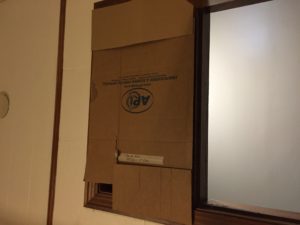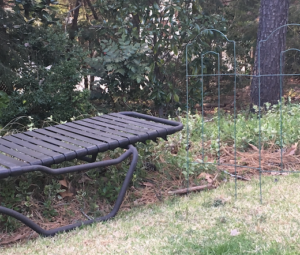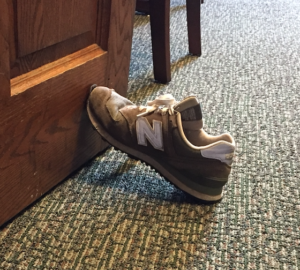On Monday May 1, Parker interviewed Brady August for half an hour about the Youth Bureau Street Outreach team. We discussed the origin of the street outreach program, its mission, personnel, training, financial and non-financial resources, and traction in the community. August was very excited about the FUSE program and the housing-first initiative, but he identified a clear disconnect between developing the housing and actually getting the necessary people into the apartments. August provided further evidence that there is a need to locate and prioritize who should be in the housing first.
Author: James
Prototype Plan
Prototype Plan
Plan 1: Counseling Network
Consider the Setting:
First:
- Develop rough idea in familiar operating environment (i.e. classroom setting)
- Familiar setting will help us prototype rapidly to create visual manifestations of our initial ideas/concepts
- Utilize whiteboards, classroom materials, and sticky notes
- Prototype all ideas from Ideation Summary
Second:
- Introduce prototype into the community
- United Methodist Church soup kitchen
- Mayor’s Office meetings (Cherri and Suzanna)
- Center for the Homeless
- South Bend Correctional Facility
- We believe that we will learn most from seeing our prototype in the context in which it will ultimately be used
- Challenging to evaluate the effects/impacts of our prototype on the homeless population, as the behavior, reactions, and responses of homeless individuals is often unpredictable
Define What to Test:
First:
- We would like to receive feedback on all of our testing. This feedback will come from individuals already working on solving the homeless problem, organizations already in place to serve the homeless, and the homeless population themselves.
Second:
- We would like people to participate in our counseling program. To accomplish this we would have to run some questionnaires, surveys, or interview to see if our programs would be viable enough for people to participate in them. In addition seeing if people recommend the counseling program could help see if these programs could successfully spread.
Third:
- Our ultimate goal is to see a positive impact and reduction in the chronically homeless population of South Bend. It will be important to study if the behaviors of the homeless change in response to the introduction of counseling.
Define Feedback Activities:
- Arrange for conversation to present our prototype to experts and homeless individuals
- “Would this be implementable in South Bend? What are the obstacles?”
- “Would this help the homeless population gain awareness and access to resources as well as motivation that they didn’t have prior?”
- “How could we make this network even better/more useful?”
- “Who could be the sponsors behind this project? The City? Center for Homeless? Notre Dame?”
Plan 2: Communal Housing
Consider The Setting:
We would create a floor-plan for this housing space using glue and foam boards in class. Creating this prototype in class would be the fastest and easiest way to build this rough model.
Define What to Test:
- Would the City be willing to subsidize a project like this?
- Is this temporary housing helping individuals work towards permanent housing?
- Do they take care of the apartments?
- Does living in close quarters with other homeless individuals work well? (i.e. no drug use)
- Would these help put strain away from housing projects already in place? (i.e. center for the homeless)
Define Feedback Activities:
- Arrange for conversation to present our prototype to experts and homeless individuals
- “Would this be implementable in South Bend? What are the obstacles?”
- “How could we make this housing plan even better/more useful?”
- “Would this fulfill a need that is not currently met?”
- “Who could be the sponsors behind this project? The City? Center for Homeless? Notre Dame?”
- Talk to contacts involved with the City of South Bend government
- Talk to homeless shelters/programs already in place to see if they would be willing to change their model
Plan 3: Food Delivery on Bikes
Consider The Setting: We would employe the homeless in areas where there would be high demand for delivery food. This can be tested by seeing if we would be able to bike back to downtown after imaging we were delivering food from various locations.
Define What to Test:
- Would food delivery companies be willing to implement this?
- How much would they be willing to pay?
- Would they hire someone with minimal work experience?
- Would the City be willing to give some sort of financial incentive to companies willing to implement this program?
- Would this program be able to run during the winter season?
Define Feedback Activities:
- Arrange for conversation to present our prototype to companies as well as the town
- Work with Mayor’s office in their homeless focus group
- Speak directly with homeless population on their new stream of income
Create Solution Evaluation Matrix:
| Criteria | Weight | Rating | Score |
| Feedback | 0.33 | 1 2 3 4 | |
| Implementation Timeframe | 0.33 | 1 2 3 4 | |
| Financial Viability | 0.33 | 1 2 3 4 | |
| Totals | 100% | 1 2 3 4 |
MAX SCORE: 1.32
Ethnography Summary – Daniel on SB Ave.
On Friday, Parker, Matt and I interviewed Daniel, a chronically homeless man that is usually on the corner of S Bend Ave and Ironwood.
Ethnography Summary: Daniel
Date: 3/3/17
Type: Interview
Location/Time: Corner of S Bend Ave and Ironwood, where he was sitting/walking around asking for money at 10am on Friday 3/3
Team Participants: Sarah Riehl, Matthew McCormick, Parker Mathes
User Characteristics:
- Chronically homeless
- Male, age 34
- Physically disabled
- Bilateral drop foot
- Seizures
- Has seizures
Top 3 Learnings:
- South Bend has strong programs in place to provide the necessary, day-to-day resources.
- Losing an address when becoming homeless can cause significant issues to receiving necessary medication.
- Daniel was homeless with his wife, which put a lot of pressure on their relationship and made it difficult to remain positive and happy.
Takeaways:
- There is a clear lack of accessibility to transitional housing for those financially unable to move into permanent housing.
- Incredibly unique story of homelessness, physical disability can be even more challenging to deal with than substance abuse or mental illness.
- The resources available to acquire food are incredibly beneficial.
Memorable Quotes:
- “I was living a normal life until my concussion in high school football changed everything.”
- “My wife’s family won’t speak to me because they think I dragged her into homelessness with me. It’s tough because I love her and want to speak with her family.”
- “Acquiring and maintaining a job with a physical disability has been one of the most difficult aspects of my life. Without a steady income stream, it’s tough to get by.”
- “I just need to get in transitional housing. Then things will get better for my wife and I. Until then, things will be challenging.”
Gallery Day Reflection – Parker
Additional Takeaways: from Suzanna and Cherri
- Need to interview homeless people of differing demographics (i.e. women, African-American)
- Need to define chronic homelessness
- Need to hone in on one specific group of the homeless population, instead of trying to analyze the entirety of the group (i.e. mentally ill, alcohol abuse, opioid abuse)
- What role has trauma played in their lives?
- Do these men/women have ID’s?
- Need to further assess the competency of the educational programs offered
Analogous Immersion Reflection
In his earlier blog post, Matt’s description of the difficulty we experienced moving people into “permanent housing” was spot on. The limited resources that the simulation provides creates a major roadblock that we believe is similarly experienced by homeless support systems throughout the country.
The one portion of the simulation that was not taken into account was the challenge of working with homeless people individually and looking at their individual needs. From the research we have collected, every homeless individual has different needs, thus intensifying the challenge of moving the entire homeless population into permanent, let alone temporary, housing.
No simulation can be perfect, but we thought it was important to note the other factors that contribute to the difficulty in delivering permanent housing.
Card Sort Reflection
To piggyback on Sarah’s prior blog post on the card sort, I wanted to note a key takeaway for the responses we received ranking the importance of “resources.” Oak Lawn, which is a local institution in Elkhart that provides mental health and addiction treatment services, was ranked last on the list. We found this interesting because of the large percentage of the South Bend homeless population that struggles with mental health and addiction issues. Our focus group noted the importance of immediate resources, like Social Services and Soup Kitchens, but they did not value the longer-term solutions as highly. Obviously immediate resources are necessary for day-to-day survival, but it was interesting to see a significantly decreased emphasis on the importance of the long-term horizon. Their list of responses definitely begs the question, “Is this homeless group not seeking attention for mental health and addiction issues? Or is it too difficult to both seek attention and get by day-to-day?”
Workarounds – Parker
Parker’s Workarounds:

#1: Although challenging to see because the picture is tiled to the left, the cardboard box is taped over the window above our door to block out the early morning light.

#2: My dog recently injured her leg, and to keep her from reinjuring herself, we attempted to build an enclosure in my backyard. When we ran out of fence, instead of purchasing more, we decided to use 2 lawn chairs to finish the area.

#3: While perusing through my dorm, I noticed another student propped his door open with his shoe because he was tired of it slamming closed. Pretty smart because the slamming can be quite disturbing.
Expert Interview – Cherri Peate
Ethnography Summary: Cherri Peate
Date: 2/8/17
Type: Interview
Location: Mendoza College of Business
Team Participants: Paul Cepak, Matthew McCormick, & Parker Mathes
User Characteristics:
- Community Outreach Director — Office of the Mayor
- 2013 – Present (4 yrs.)
- Indiana University and DePaul graduate
- Sociology concentration
- Statistics/Research
- Female
- Passion for public policy
- Primary focus lies in areas other than homelessness
Abstract: Cherri is was our first touchpoint. We had a 40 minute conference call in which we learned more about the parameters of our project and the problem of homeless in South Bend. We refined our scope to chronic homelessness with a specific focus on how the issues of mental health and criminal records affect individuals trying to escape homelessness and regain sustainable independence.
What is this person’s greatest asset to our project? Knowledge and Network. Through our conversation we were quickly brought up to speed on all necessary information and immediately put in touch with other individuals/organizations in the community. Leveraging Cherri’s network was an important launching pad for our project.
Top 3 Learnings:
- The scope of our project will focus on those categorized as being chronically homeless, addressing both how to get them out of their current state of homelessness and how to prevent them from falling back into homelessness.
- Perspective: Eyes of someone about to be homeless
- South Bend has many resources for the homeless population, including the Center for the Homeless, weather amnesty, and many soup kitchens. There are programs in place. Now how do we help drive improvement?
- A large percentage of chronically homeless individuals are afflicted with a mental illness, increasing the difficulty of exiting their current state of homelessness. Additionally, many also have criminal records, decreasing the likelihood of receiving sustainable future employment.
Key Insights:
- Cherri helped us realize there are many people we can reach out to and many different volunteer/interview opportunities available on a weekly basis
- Although seemingly obvious, many of the homeless individuals struggle with extenuating circumstances (i.e. mental illness, criminal record, & injury)
- Point in Time statistics provide accurate numbers on SB homeless population
Memorable Quote:
“You need to step into their shoes to gather information and devise insightful solutions. Your perspective needs to be from the eyes of someone about to be homeless”
Takeaway:
- Statistics of SB homeless population
- Reach out to Rob Booker, director at SB corrections facility
- Initial contact with Center for the Homeless
- Attend soup kitchen downtown on Friday’s
5 “E” Framework
Entice:
- Reach out initially over email
- Set up phone call 4pm February 8th
Enter:
- Do initial research on SB homeless population
- Prepare questions for Cherri
- Locate destination and coordinate logistics
Engage:
- Conference call with Cherri
- Absorb information on SB homeless population
- Ask questions
Exit:
- Ask Cherri for next steps
- Rob Booker, SB corrections facility
- Center for Homeless
Extend:
- Begin to utilize Cherri’s network
- Reach out Rob, set up time to meet in person
- Attending the downtown soup kitchen, engage homeless population for firs time
Ethnography Interview with Rodney Smith at Soup Kitchen
Date: 2/17/17
Location: United Methodist Church
Participants: Paul and Parker
Profile of Interviewee:
- Male, mid 40’s
- White
- SB native
- Criminal Record
- Questionable substance abuse (current or prior)
- Unemployed
Summary: On February 17, we interviewed Rodney Smith (alias), at the Downtown Soup Kitchen and Food Pantry. Over the course of the last 15 years, Rodney has bounced around South Bend, living in the Center for the Homeless and many different friends’ apartments. He has a criminal criminal record (3 Felonies from the early 2000’s), a knee injury, and is recovering from substance abuse. We were able to learn many different things about the South Bend homeless community from his many experiences in various living arrangements. He is currently taking classes at the Center for the Homeless in hopes of landing a job interview when his knee is back to full health. Rodney seemed to be back on the right track in his life, but with a criminal record, an injury, and prior substance abuse, he was the first to admit that even finding an interview will not be an easy task.